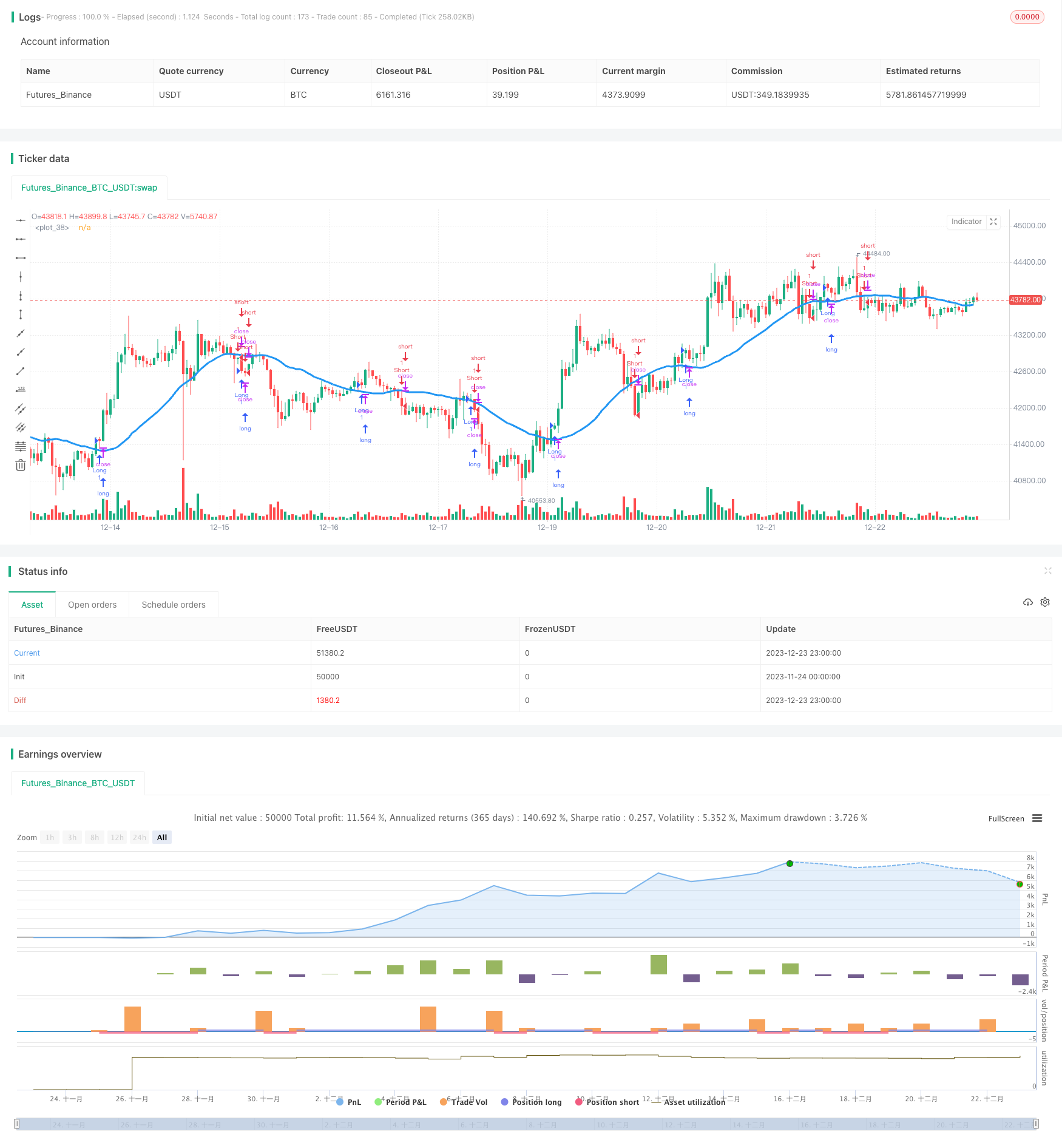
概述
该策略通过计算不同类型的移动平均线,判断价格趋势方向,实现单边开仓。当价格突破移动平均线时开仓做多或做空。
策略原理
该策略允许选择7种不同的移动平均线类型,包括简单移动平均线(SMA)、指数移动平均线(EMA)、成交量加权平均线(VWMA)、双指数移动平均线(DEMA)、三指数移动平均线(TEMA)、考夫曼自适应移动平均线(KAMA)和价格通道中线。通过计算所选移动平均线和收盘价的关系来判断价格趋势方向。
当收盘价从下向上突破移动平均线时,判断为涨势,开仓做多;当收盘价从上向下突破移动平均线时,判断为跌势,开仓做空。这样可以捕捉价格趋势的转折点,实现单边开仓。
优势分析
该策略具有以下优势:
可以选择多种移动平均线类型,灵活适应不同品种和周期。
单边开仓,可以有效控制风险。
顺势开仓,容易获利。
容易理解和实现。
风险分析
该策略也存在一些风险:
当价格在移动平均线附近震荡时,会出现多次错误信号和反向开仓。可以设置适当的止损来控制风险。
无法完全避免因价格快速上涨或下跌带来的风险。可以结合其他指标判断趋势信号。
分析师需要选择合适的移动平均线参数,不合适的参数容易产生交易信号的滞后。
优化方向
该策略可以从以下几个方面进行优化:
结合其他技术指标判断趋势信号,例如MACD、RSI等,形成交易组合。
添加止损逻辑。移动止损或挂单止损。
对参数进行测试和优化,选择最佳的参数组合。例如移动平均线周期、移动平均线类型等参数。
可以考虑挂单立即成交类型的进入策略,追踪趋势运行。
总结
该策略基于移动平均线判断价格趋势方向,实现单边开仓。使用简单,容易实现,可以有效控制风险。但也可能出现错误信号和反向开仓的风险。通过组合其他指标判断信号,优化参数,添加止损等方式可以不断改进该策略,使之更稳定和可靠。
策略源码
/*backtest
start: 2023-11-24 00:00:00
end: 2023-12-24 00:00:00
period: 1h
basePeriod: 15m
exchanges: [{"eid":"Futures_Binance","currency":"BTC_USDT"}]
*/
//@version=2
strategy(title = "Noro's MAs Tests v1.1", shorttitle = "MAs tests 1.1", overlay=true, default_qty_type = strategy.percent_of_equity, default_qty_value=100.0, pyramiding=0)
needlong = input(true, "long")
needshort = input(true, "short")
len = input(30, defval = 30, minval = 2, maxval = 1000, title = "MA length")
type = input(1, defval = 1, minval = 1, maxval = 7, title = "Type")
src = input(close, defval = close, title = "Source")
anti = input(true, defval = true, title = "Antipila")
//DEMA
dema = 2 * ema(src, len) - ema(ema(close, len), len)
//TEMA
xPrice = close
xEMA1 = ema(src, len)
xEMA2 = ema(xEMA1, len)
xEMA3 = ema(xEMA2, len)
tema = 3 * xEMA1 - 3 * xEMA2 + xEMA3
//KAMA
xvnoise = abs(src - src[1])
nfastend = 0.20
nslowend = 0.05
nsignal = abs(src - src[len])
nnoise = sum(xvnoise, len)
nefratio = iff(nnoise != 0, nsignal / nnoise, 0)
nsmooth = pow(nefratio * (nfastend - nslowend) + nslowend, 2)
kama = nz(kama[1]) + nsmooth * (src - nz(kama[1]))
//PriceChannel
lasthigh = highest(src, len)
lastlow = lowest(src, len)
center = (lasthigh + lastlow) / 2
ma = type == 1 ? sma(src, len) : type == 2 ? ema(src, len) : type == 3 ? vwma(src, len) : type == 4 ? dema : type == 5 ? tema : type == 6 ? kama : type == 7 ? center : 0
plot(ma, color = blue, linewidth = 3, transp = 0)
trend = anti == false and close > ma ? 1 : anti == false and close < ma ? -1 : low > ma ? 1 : high < ma ? -1 : trend[1]
longCondition = trend == 1 and trend[1] == -1
if (longCondition)
strategy.entry("Long", strategy.long, needlong == false ? 0 : na)
shortCondition = trend == -1 and trend[1] == 1
if (shortCondition)
strategy.entry("Short", strategy.short, needshort == false ? 0 : na)